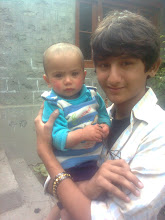Allama Hassan Turabi (Urdu: علامہ حسن ترابی) was a Pakistani and prominent Shiite Muslim cleric, chief of the main Shiite political party, Tehrik-e-Jafaria Pakistan. He was assassinated by a Sunni Bangladeshi on 14 July 2006 following his return from an anti-Israel protest regarding the 2006 Israel-Lebanon conflict.
Early life
He was born in 1940 at Shigar district of Baltistan area of Jammu & Kashmir. After completing his secondary education he got admission in a madressa at Skardu, he then migrated to Karachi and got his masters degree from University of Karachi. He also went to Qom for studying at Hauza Ilmiya.
He became the Khateeb of a shia Jamia Mosque at Mehmoodabad in Karachi in 1984 after his returning from Qom.
Political career
He joined Tehrik-e-Nifaz-e-Fiqh-e-Jafaria in mid 80's and in almost 1989 he become the divisional president of organization. Due to his immense interest in national politics he become the provincial General Secretary of Tehrik.
Later on in the 90's the whole of shia nation faced strong terrorism backed by America and Saudi Wahabis and he was everywhere in country to support the nation. The organization changed its name to Tehrik-e-Jafaria Pakistan. In 1999 this organization was banned by the Musharraf Government, so scholars of the organization formed another platform named Tehrik-e-Islami and after that the current organization Shia Ulema Council. He was the Also hold a strong position in Muttahida Majlis-e-Amal the united front of six Islamic parties of Pakistan.
His Struggle for Muslim Unity
He always made efforts for uniting Muslims of different schools of thought and condemned any effort to sabotage the Muslim unity. Ironically, he was killed by a Sunni.
Soldier of Wilayat-e-Faqeeh
He became the preacher and follower of "Guardianship of the Islamic Jurists" (Arabic: ولاية الفقيه Wilayat al-Faqih) school of thought and tried to work to preach the thoughts of Imam Khomeini and Ali Khamenei. Guardianship of the [Islamic] Jurists is a Twelver doctrine regarding Islamic leadership.
Death
Karachi has been the scene of bloody rivalry between Pakistan's majority Sunnis and minority Shiites since the 1980s. [1]
Turabi, Shiite Muslim cleric, was attacked in Karachi several times by what he believed to be the agents of theUnited States whom he claimed to be international terrorists allied with Al-Qaeda and Lashkar-e-Jhangvi. The last unsuccessful attempt was made on 6th April 2006 near his residence at Abbas Town in which he escaped. [2]This attack was accomplished by blasting a remotely controlled bomb hidden under a fruit cart as he climbed into his car outside his home. Two bodyguards and a passerby were hurt in that incident, and the car was severely damaged.
The final attempt made on 14 July 2006 succeeded. At a rally that was organized by Muttahida Majlis Amal to protest Israel's role in the 2006 Israel-Lebanon conflict. When he reached his in Karbala, he got out of his jeepand was killed by a 16-year-old (some sources say 25 year old) [3] Bangladeshi suicide bomber Abdul Karim, who was disguised as beggar. Kalim was wearing a 2.5 kg explosive (some sources say 1 kg [4]) loaded jacket blasted himself when shaking hands with his house main gate, in this attacked he lost his life, his 10 year old nephew Ali Imran died, one guard died, and Three policemen were wounded in the suicide bomb attack at Abul Hassan Isphahani Road at Gulshan-e-Iqbal Town . [5]
The bomber said in his video message that he is carrying out the attack on his own and that he is happy to do so[6], but according to Sindh provincial police chief, Jehangir Mirza, [7] police have arrested three suspected Pakistani Wahabi militants for planning the assassination. The detained trio were identified Mohammed Amin,Sultan Mahmood and Mohammed Rahman and they belonged to outlawed Pakistani militant groups Lashkar-e-Jhangvi, Sipah-e-Sahaba and Jaish-e-Mohammed respectively.
 Shigar Fort Residence is located in the beautiful province of Baltistan in the Northern Areas of Pakistan. Its picturesque setting in the Shigar Valley provides the ideal gateway from which to explore some of the most spectacular scenery in the world. Here, the magnificent Karakoram and Himalayan ranges meet - an intersection which results in the most extensively glaciated high mountain terrain on the planet. This includes seven of the world's 25 highest peaks, four of which exceed 8000m, including K-2, the second highest mountain peak in the world at 8611m.
Shigar Fort Residence is located in the beautiful province of Baltistan in the Northern Areas of Pakistan. Its picturesque setting in the Shigar Valley provides the ideal gateway from which to explore some of the most spectacular scenery in the world. Here, the magnificent Karakoram and Himalayan ranges meet - an intersection which results in the most extensively glaciated high mountain terrain on the planet. This includes seven of the world's 25 highest peaks, four of which exceed 8000m, including K-2, the second highest mountain peak in the world at 8611m. Baltistan is home to approximately 400,000 people, whose history and culture stretches back to early Tibetan Buddhist origins. This heritage is still evident in much of the local traditions, architecture and language of the area, offering visitors a rich cultural experience unique in Pakistan.
Baltistan is home to approximately 400,000 people, whose history and culture stretches back to early Tibetan Buddhist origins. This heritage is still evident in much of the local traditions, architecture and language of the area, offering visitors a rich cultural experience unique in Pakistan.

